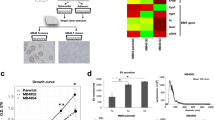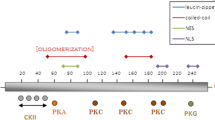Abstract
We have recently characterized a human bladder cancer cell line T24 and a more aggressive lineage related variant of it, T24T. To gain further insights, we have studied their metastatic ability in an in vivo model system. Results show that T24 forms significantly fewer [4/12 (1/11) mice had metastases with 1-2 lesions/mouse] metastasis in SCID/bg mice than T24T [14/14 (6/6) mice had metastases with a mean of 24-28 lesions/mouse]. To begin exploring the mechanisms underlying this difference, we evaluated the mRNA and protein expression levels of metastasis-suppressor genes, known to be important in the progression of other cancers, in our model of bladder cancer progression. A higher mRNA expression of BRMS1, a metastasis suppressor in breast cancer, was observed in T24 cells. In addition, RhoGDI2 mRNA expression was only observed in T24 when compared to T24T, suggesting that Rho activation might play a significant role in the metastatic cascade. However, a basal level mRNA expression of KISS1, described as metastasis suppressor in melanoma and breast, was observed in both the lines and had slightly higher expression in T24T. No difference of Nm23-H1, KAI1, MKK4/SEK1 and E-Cadherin protein levels were noted between these two lines. In summary, it appears that the T24/T24T paired cell lines constitute a useful model for the study of human bladder cancer metastasis that will allow both the discovery and mechanistic evaluation of genes potentially involved in this process.
Similar content being viewed by others
References
Greenlee RT, Murray T, Bolden S et al. Cancer statistics, 2000. CA Cancer J Clin 2000; 50(1): 7–33.
Skinner DG, Stein JP, Lieskovsky G et al. 25-year experience in the management of invasive bladder cancer by radical cystectomy. Eur Urol 1998; 33(Suppl 4): 25–6.
von der Maase H, Hansen SW, Roberts JT et al. Gemcitabine and cisplatin versus methotrexate, vinblastine, doxorubicin, and cisplatin in advanced or metastatic bladder cancer: Results of a large, randomized, multinational, multicenter, phase III study. J Clin Oncol 2000; 18(17): 3068–77.
Fidler IJ. Critical factors in the biology of human cancer metastasis. Am Surg 1995; 61(12): 1065–6.
Yoshida BA, Sokoloff MM, Welch DR et al. Metastasis-suppressor genes: A review and perspective on an emerging field. J Natl Cancer Inst 2000; 92(21): 1717–30.
Knowles MA, Elder PA, Williamson M et al. Allelotype of human bladder cancer. Cancer Res 1994; 54(2): 531–8.
Li M, Zhang ZF, Reuter VE et al. Chromosome 3 allelic losses and microsatellite alterations in transitional cell carcinoma of the urinary bladder. Am J Pathol 1996; 149(1): 229–35.
Polascik TJ, Cairns P, Chang WY et al. Distinct regions of allelic loss on chromosome 4 in human primary bladder carcinoma. Cancer Res 1995; 55(22): 5396–9.
Wagner U, Bubendorf L, Gasser TC et al. Chromosome 8p deletions are associated with invasive tumor growth in urinary bladder cancer. Am J Pathol 1997; 151(3): 753–9.
Cappellen D, Gil Diez de Medina S, Chopin D et al. Frequent loss of heterozygosity on chromosome 10q in muscle-invasive transitional cell carcinomas of the bladder. Oncogene 1997; 14(25): 3059–66.
Wheeless LL, Reeder JE, Han R et al. Bladder irrigation specimens assayed by fluorescence in situ hybridization to interphase nuclei. Cytometry 1994; 17(4): 319–26.
Reznikoff CA, Belair CD, Yeager TR et al. A molecular genetic model of human bladder cancer pathogenesis. Semin Oncol 1996; 23(5): 571–84.
Brewster SF, Gingell JC, Browne S et al. Loss of heterozygosity on chromosome 18q is associated with muscle-invasive transitional cell carcinoma of the bladder. Br J Cancer 1994; 70(4): 697–700.
Theodorescu D, Cornil I, Fernandez BJ et al. Overexpression of normal and mutated forms of HRAS induces orthotopic bladder invasion in a human transitional cell carcinoma. Proc Natl Acad Sci USA 1990; 87(22): 9047–51.
Theodorescu D, Cornil I, Sheehan C et al. Ha-ras induction of the invasive phenotype results in up-regulation of epidermal growth factor receptors and altered responsiveness to epidermal growth factor in human papillary transitional cell carcinoma cells. Cancer Res 1991; 51(16): 4486–91.
Gildea JJ, Golden WL, Harding MA et al. Genetic and phenotypic changes associated with the acquisition of tumorigenicity in human bladder cancer. Genes Chromosomes Cancer 2000; 27(3): 252–63.
Bubenik J, Baresova M, Viklicky V et al. Established cell line of urinary bladder carcinoma (T24) containing tumour-specific antigen. Int J Cancer 1973; 11(3): 765–73.
Seraj MJ, Samant RS, Verderame MF et al. Functional evidence for a novel human breast carcinoma metastasis suppressor, BRMS1, encoded at chromosome 11q13. Cancer Res 2000; 60(11): 2764–9.
Sheta EA, Harding MA, Conaway MR et al. Focal Adhesion Kinase, Rap1, and transcriptional induction of vascular endothelial growth factor. J Natl Cancer Inst 2000; 92(13): 1065–73.
Theodorescu D, Broder SR, Boyd JC et al. p53, bcl-2 and retinoblastoma proteins as long-term prognostic markers in localized carcinoma of the prostate. J Urol 1997; 158(1): 131–7.
Fukudome K, Furuse M, Imai T et al. Identification of membrane antigen C33 recognized by monoclonal antibodies inhibitory to human T-cell leukemia virus type 1 (HTLV-1)-induced syncytium formation: altered glycosylation of C33 antigen in HTLV-1-positive T cells. J Virol 1992; 66(3): 1394–401.
Paul R, Ewing CM, Jarrard DF et al. The cadherin cell-cell adhesion pathway in prostate cancer progression. Br J Urol 1997; 79(Suppl 1): 37–43.
Habets GG, Scholtes EH, Zuydgeest D et al. Identification of an invasion-inducing gene, Tiam-1, that encodes a protein with homology to GDP-GTP exchangers for Rho-like proteins. Cell 1994; 77(4): 537–49.
Lelias JM, Adra CN, Wulf GM et al. cDNA cloning of a human mRNA preferentially expressed in hematopoietic cells and with homology to a GDP-dissociation inhibitor for the rho GTP-binding proteins. Proc Natl Acad Sci USA 1993; 90(4): 1479–83.
Bourguignon LY, Zhu H, Shao L et al. Ankyrin-Tiam1 interaction promotes Rac1 signaling and metastatic breast tumor cell invasion and migration. J Cell Biol 2000; 150(1): 177–91.
Clark EA, Golub TR, Lander ES et al. Genomic analysis of metastasis reveals an essential role for RhoC [see comments]. Nature 2000; 406(6795): 532–5.
OToole CM, Povey S, Hepburn P et al. Identity of some human bladder cancer cell lines. Nature 1983; 301(5899): 429–30.
Vogelstein B, Kinzler KW. The multistep nature of cancer. Trends Genet 1993; 9(4): 138–41.
Fidler IJ. Critical determinants of cancer metastasis: rationale for therapy. Cancer Chemother Pharmacol 1999; 43(Suppl): S3–10.
Dong JT, Lamb PW, Rinker-Schaeffer CW et al. KAI1, a metastasis suppressor gene for prostate cancer on human chromosome 11p11.2. Science 1995; 268(5212): 884–6.
Backer JM, Mendola CE, Kovesdi I et al. Chromosomal localization and nucleoside diphosphate kinase activity of human metastasis-suppressor genes NM23-1 and NM23-2. Oncogene 1993; 8(2): 497–502.
Freije JM, MacDonald NJ, Steeg PS. Nm23 and tumour metastasis: basic and translational advances. Biochem Soc Symp 1998; 63261-71.
Miele ME, De La Rosa A, Lee JH et al. Suppression of human melanoma metastasis following introduction of chromosome 6 is independent of NME1 (Nm23). Clin Exp Metastasis 1997; 15(3): 259–65.
Miele ME, Robertson G, Lee JH et al. Metastasis suppressed, but tumorigenicity and local invasiveness unaffected, in the human melanoma cell line MelJuSo after introduction of human chromosomes 1 or 6. Mol Carcinog 1996; 15(4): 284–99.
Lee JH, Miele ME, Hicks DJ et al. KiSS-1, a novel human malignant melanoma metastasis-suppressor gene [see comments] [published erratum appears in J Natl Cancer Inst 1997 Oct 15; 89(20): 1549]. J Natl Cancer Inst 1996; 88(23): 1731–7.
Lee JH, Welch DR. Suppression of metastasis in human breast carcinoma MDA-MB-435 cells after transfection with the metastasis suppressor gene, KiSS-1. Cancer Res 1997; 57(12): 2384–7.
Sasaki T, Takai Y. The Rho small G protein family-Rho GDI system as a temporal and spatial determinant for cytoskeletal control. Biochem Biophys Res Commun 1998; 245(3): 641–5.
Isomura M, Kikuchi A, Ohga N et al. Regulation of binding of rhoB p20 to membranes by its specific regulatory protein, GDP dissociation inhibitor. Oncogene 1991; 6(1): 119–24.
Phillips KK, Welch DR, Miele ME et al. Suppression of MDA-MB-breast carcinoma cell metastasis following the introduction of human chromosome 11. Cancer Res 1996; 56(6): 1222–7.
Saunders MM, Seraj MJ, Li Z et al. Breast cancer metastatic potential correlates with a breakdown in homospecific and heterospecific gap junctional intercellular communication. Cancer Res 2001; 61(5): 1765–7.
Author information
Authors and Affiliations
Rights and permissions
About this article
Cite this article
Seraj, M.J., Harding, M.A., Gildea, J.J. et al. The relationship of BRMS1 and RhoGDI2 gene expression to metastatic potential in lineage related human bladder cancer cell lines. Clin Exp Metastasis 18, 519–525 (2000). https://doi.org/10.1023/A:1011819621859
Issue Date:
DOI: https://doi.org/10.1023/A:1011819621859




